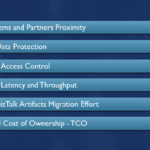Questions Logistics/Freight forwarding companies should ask themselves when planning an integration strategy
1.How do you plan on making cargo services more profitable? Through customer intimacy, operational efficiency or product/service innovation?
Deciding upon a competitive strategy early on in your integration strategy helps to develop an integration solution tailored to meet these objectives. If you are betting on improving operational efficiency, you’ll likely focus on automating processes and work procedures.
2. What have revenues and margins been like the last few years and what do projections look like?
3. How will the cargo company incorporate “Straight through processing” in its operations?
Straight through processing calls for all (common) business transactions to involve no people end to end. This is generally part of a broader Operational efficiency initiative.
4. How will the freight forwarding or the cargo company make its operations efficient, especially through building relationships in shipper and carrier networks?
This relates to building broader relationships with a targeted consumer segment or group of customers. Deloitte advises to leverage economies of scope through new combinations of boundary-spanning products/services and information.
5. What companies are key competition for our company and how do we plan on differentiating from them?
Keeping a close eye on the competition, that whether they’re investing more in operational efficiency or service innovation, can also help you identify your strengths and future direction. Accenture identified the key attributes of high-performance logistics & freight forwarding companies. They use IT to maintain 360-degree control along with using new ocean freight links to growth geographies such as Africa.
6. Is this level of planning a formal process at our company?
7. What are key initiatives for the next 1-2 years?
Integration initiatives need a significant commitment of resources, both human and capital. You won’t prefer to start two competing initiatives at the same time.
8. What are key business goals and how does this platform/initiative help you achieve those business objectives?
Always align your integration strategy/initiatives to key business goals that the organization plans to achieve in next 1-2 years.
9. From a sales and marketing perspective, how does that happen right now? Are you expecting to expand to new target markets?
10. If providing value added services (VAS) is a key objective here, what VAS are of key importance? Supply chain visibility, Customer clearance, Self-service, warranty processing, returns management, light manufacturing?




![BizTalk Migration to Azure iPaaS – Lift & Shift vs Hybrid Integration [Part 2]](https://alliedc.com/wp-content/uploads/2019/11/organ-Wootten-7-150x150.png)


